Overview
- Brief Narrative
- Floral patterned, fringed wall hanging created by Sophia Swaab de Groot in 1938 or 1939 in Arnhem, Netherlands, and recovered by her son Louis after the war. Sophia made the wall hanging to protect the wall behind the living room couch. She worked on it for hours over several nights and used a paper pattern to create it. Germany occupied the Netherlands in May 1940 and implemented anti-Jewish restrictions. In July 1942, the Germans began mass deportations. On November 16, 1942, Chelly, 15, Louis, 13, and their parents Meijer and Sophia left Arnhem and went into hiding. Meijer and Sophia hid in Amsterdam while Chelly and Louis moved around to different locations. In summer/fall 1943, Chelly went to Amsterdam to live with her parents. In December, Louis was sent to Lemmer to live with the Onderweegs family. In February 1944, Dirk Onderweegs visited and offered to take Chelly to a safer hiding place. On April 8, 1944, four days before Dirk was to return, Chelly and her parents were denounced and arrested. They were sent to Westerbork transit camp, then to Auschwitz where Chelly and Sophia were killed upon arrival on May 22, 1944. Meijer was selected for a work detail and was killed on September 30, 1944. Louis remained in hiding with Onderweegs until liberation in mid-April 1945.
- Date
-
creation:
1938-1939
recovered: 1946 August-1950
- Geography
-
creation:
Arnhem (Netherlands)
- Credit Line
- United States Holocaust Memorial Museum Collection, Gift of Louis de Groot
- Contributor
-
Subject:
Sophia de Groot
Artist: Sophia de Groot
Subject: Louis de Groot
- Biography
-
Sophia Swaab was born on June 10, 1900, in Utrecht, Netherlands, to Meijer and Heintje van Leeuwen Swaab. Sophia had six siblings: Leentje (Lea), born April 6, 1896, Philip, born September 12, 1898, Esther, born circa 1900, Nathan, born October 18, 1901, Mietje (Miriam), born December 4, 1909, and Jozef, born circa 1910. Sophia’s father Meijer was born circa 1877 in Utrecht, to Joseph (b. 1838) and Leentje de Groote (b. 1853) Swaab. Sophia’s mother Heintje was born circa 1878 in Zwolle, to Philip and Esther de Groot van Leeuwen. Meijer and Heintje married on December 22, 1897. Meijer was a greengrocer and sold fruits and vegetables. They also owned a shop that sold late night snacks. Sophia managed the snack shop until she married her childhood friend Meijer de Groot in 1922. Meijer was born on October 9, 1897, in Utrecht. Meijer had five siblings: Israel, Salomon, Izak, Mozes, and Julia. Meijer’s father died when he was very young, so he was raised by his mother, Rachel Bloemendaal de Groot. Meijer and Sophia moved to Amersfoort and had two children: Rachel (Chelly), born August 8, 1927, and Levie (Louis), born June 28, 1929. Sophia’s brother Jozef died on April 28, 1930. In 1932, Sophia and her family moved to Arnhem. Meijer owned a hardware and electrical appliance store. They were comfortable but not wealthy. They attended synagogue weekly and observed every holiday. Sophia’s father Meijer died on August 29, 1934. Her brother Nathan died on October 18, 1935, and her mother Heintje died on December 10. Meijer and Sophia were involved with the Jewish Refugee Committee and assisted Jews fleeing from Germany. After the Kristallnacht pogrom occurred in Germany and Austria in November 1938, they took in an Austrian Jewish Kindertransport refugee, Eva Haller.
On May 10, 1940, Germany invaded the Netherlands. Meijer found a taxi driver who was willing to take them to a port city in the west so they could go to England. They could not get out because the Dutch army had flooded the roads. The Netherlands surrendered on May 14. The German authorities gradually implemented anti-Semitic measures. Jews were no longer allowed to swim in public pools or go to the parks. They were only allowed to shop between 3 and 5 PM. In late 1940, Sophia’s brother-in-law Israel was arrested and jailed on suspicion of working with the resistance. He had a trial and was released in February 1941. Beginning on May 1, 1942, Jews were required to wear Star of David badges. Mass deportations began in July 1942. As the situation worsened, Meijer and Sophia planned to go into hiding. They bought food off the black market and preserved it to take with them. They stored the food with one of their neighbors and their furniture with the other. On November 16, 1942, Dutch police warned Sophia’s family that a raid was planned for that night. Louis and Chelly stayed the night with one of Meijer’s employees, Herman Lagenbach. Meijer and Sophia arranged to hide with the neighbor who had their furniture, but he refused to let them in the next day. They went to Hilversum, where Sophia’s brother-in-law Israel was in hiding. He had contacts in the resistance and helped them find hiding places. Chelly went to a home in Hilversum, while Sophia, Meijer, and Louis went to Amsterdam. Sophia and Meijer sent Louis to Den Helder. They stayed in Amsterdam with Geertruida (Truus) Eweg, who rented them a room with kitchen privileges. Louis returned to Amsterdam in December. He had been turned in by a neighbor and saved by a Dutch policeman. Truus would not allow him to stay because she feared he would be too noisy. Sophia and Meijer sent Louis to a new hiding place in Wormerveer on January 1, 1943. They also moved Chelly between several hiding places, eventually moving her to a different home in Wormerveer. In the early summer, Sophia and Meijer learned that Louis was being mistreated and brought him back to Amsterdam. He was moved between about twelve different hiding places and stayed with Sophia and Meijer intermittently. In the summer or fall, they brought Chelly to Amsterdam live with them. In September 1943, all four family members were reunited. After six weeks, they went on the run. Sophia and Chelly stayed together, as did Meijer and Louis. In December, the family reunited in Amsterdam and resumed staying with Truus. Sophia and Meijer sent Louis to Friesland on December 22.
In February 1944, Sophia, Meijer, and Chelly were visited by Dirk Onderweegs, the resistance member who was hiding Louis. He offered to find a hiding place for Chelly closer to Louis. Sophia and Meijer agreed and arranged for Dirk to pick up Chelly after Easter. On April 8, Sophia, Meijer, and Chelly were denounced by Ans van Dijk, a Jewish woman who worked for the Gestapo. She thought she was turning in Meijer’s brother Izak. Jaap Grotendorst, the Dutch policeman who came for them, was a childhood friend of Meijer’s and recognized him immediately. Jaap refused a bribe and arrested them. Chelly and Sophia were held in the Amsterdam police station, then sent to jail in The Hague. After about a week, they were reunited with Meijer and sent to Westerbork transit camp. On May 19, they were loaded into wagon 9 of a transport and sent to Auschwitz concentration camp. When they arrived at Auschwitz on May 22, Sophia and Chelly were separated. Chelly cried so fiercely that the SS officer allowed her to switch places with another woman. Sophia and Chelly were sent to the gas chamber and killed. Sophia’s husband Meijer was selected for a work detail and was killed on September 30, 1944. Most of Sophia’s family was also killed in Auschwitz: her brother Philip on January 31, 1944, his wife Sara in 1943, their children Hanny, Meir, and Lion in 1943 and 1945, Sophia’s sister Miriam Vigevano on February 11, 1944, Miriam’s husband Abraham and daughter Florans in 1943, and Sophia’s brother-in-law Alexander Cohen in 1943. Sophia’s niece Elisabeth Cohen was killed in Sobibor killing center in 1943. Sophia’s son Louis survived in hiding, as did her sister Lea Cohen, Lea’s daughter Heni, Sophia’s sister Esther van der Stam, Esther’s husband Max, and their son Freddy.
Louis de Groot (1929-2020) was born Levie de Groot was on June 28, 1929, in Amersfoort, Netherlands, to Meijer de Groot (1897-1944) and Sophia Swaab de Groot (1900-1944). He had one sister, Rachel de Groot (Chelly, 1927-1944). In 1932, the family moved to Arnhem. Meijer owned a hardware and electrical appliance store. The family was religious and attended synagogue weekly. Louis and Rachel were involved with a local Jewish youth organization. Meijer and Sophia were involved with the Jewish Refugee Committee, and after Kristallnacht in November 1938 they took in an Austrian Jewish Kindertransport refugee, Eva Haller.
In May 1940, Germany invaded and occupied the Netherlands. On November 16, 1942, Meijer and Sophia were warned by Dutch police about an upcoming raid. The family went to Hilversum where Meijer’s brother Israel de Groot was in hiding and working with the Dutch Resistance. He arranged for Rachel to be hidden in Hilversum, and Louis went with his parents to Amsterdam. Louis, his sister, and his parents were all reunited in Amsterdam in December 1943. On December 22, 1943, Meijer arranged for Louis to go to Friesland to be hidden with Uilke Boonstra (1899-1944), a member of the resistance there.
On January 3, 1944, Louis was moved to the home of Dirk Onderweegs (1908-1979) and Ann Onderweegs (1910-1993), and their young daughter Bonnette Onderweegs (1940-1986) in Lemmer. They also hid Robert Wolf, a Jewish infant. Dirk used his position in Lemmer City Hall to obtain forged documents for Louis. In April 1944, Meijer, Sophia, and Rachel were arrested and deported to Westerbork. In June 1944, Dirk and Ann were reported to the Gestapo for their role in the Resistance, and they fled Lemmer with Louis and Robert. They assumed false identities, with Louis living under the name Leo Lemstra. They eventually ended up in Bolsward, where Dirk continued to be active with the Dutch Resistance. Louis was liberated in Bolsward by Canadian forces in April 1945.
After liberation, Louis and the Onderweegs returned to Lemmer. He later went to Jewish orphanage in Amsterdam. In 1947, Louis learned that his parents and sister were deported from Westerbork to Auschwitz in May 1944 and murdered. Most of Louis’ extended family were killed in the Holocaust. Louis was in Israel from 1948-1949, and then returned to the Netherlands to finish his studies.
Louis immigrated to the United States in 1950. He was drafted into the US Army and served in Germany in the Army of Occupation for two years. Louis attended Columbia University and received a degree in Economics in 1956. On June 7, 1956, Louis married Barbara Brenner (1935-2015), and they had two sons. Louis had a career in marketing with IBM, and was a volunteer at the United States Holocaust Memorial Museum.
Physical Details
- Classification
-
Decorative Arts
- Category
-
Needlework
- Object Type
-
Wall hangings (lcsh)
- Physical Description
- Rectangular, hand knitted wool yarn wall hanging with a scalloped bottom with 8 inch long, thick, dark brown, twisted fringe. Across the front are 3 large, ornate, floral and foliage designs separated by 2 smaller floral and leaf groups in blue, brown, green, yellow, orange, and white, on a light brown background. Along the upper edge is a panel of alternating green and yellow stylized leaves on an orange background, with a dark brown border. Thirty-three, large wooden rings are attached to the upper edge with bronze colored metal hooks. The hanging was constructed on thick string netting and is sewn to brown cloth backing. One ring is detached.
- Dimensions
- overall: Height: 36.875 inches (93.663 cm) | Width: 74.500 inches (189.23 cm)
- Materials
- overall : wool, cloth, wood, metal, thread
Rights & Restrictions
- Conditions on Access
- No restrictions on access
- Conditions on Use
- No restrictions on use
Keywords & Subjects
- Topical Term
- Deportees--Netherlands--Amsterdam--Biography. Hidden children (Holocaust)--Netherlands--Biography. Holocaust, Jewish (1939-1945)--Netherlands--Personal narratives. Holocaust victims--Netherlands--Biography. Jewish children in the Holocaust--Netherlands--Biography. Jews--Persecution--Netherlands--Biography. World War, 1939-1945--Underground movements--Netherlands--Personal narratives, Jewish.
Administrative Notes
- Legal Status
- Permanent Collection
- Provenance
- The wall hanging was donated to the United States Holocaust Memorial Museum in 2015 by Louis de Groot, the son of Sophia Swaab de Groot.
- Funding Note
- The cataloging of this artifact has been supported by a grant from the Conference on Jewish Material Claims Against Germany.
- Record last modified:
- 2024-10-03 12:46:34
- This page:
- https://collections.ushmm.org/search/catalog/irn605150
Download & Licensing
In-Person Research
- By Appointment
- Request 21 Days in Advance of Visit
- Plan a Research Visit
- Request to See This Object
Contact Us
Also in Louis de Groot family collection
The collection consists of beads, beadwork, two containers, a calendar, an autograph book, and a coin purse relating to the experiences of Rachel de Groot and her brother Louis de Groot during the Holocaust while in hiding in the Netherlands, and a wall hanging relating to the experiences of their mother, Sophia de Groot, before the Holocaust in Arnhem. The collection also includes original and copyprint photographs related to the wartime experiences of Louis de Groot. Includes photos of a child who was in hiding with de Groot. Includes blank forms concerning labor. Some of these materials may be combined into a single collection in the future.
Date: 1938-1945
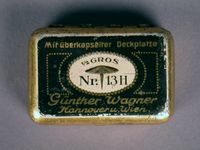
Tin box used to store beads by a Dutch Jewish girl in hiding
Object
Günther Wagner tack box used by Rachel “Chelly” de Groot from November 1942 to April 1944 and recovered by her brother Louis after the war. Chelly used the box to store unfinished red glass beadwork and small glass beads that she used to make handicrafts. Nazi Germany invaded the Netherlands on May 10, 1940, and implemented anti-Jewish restrictions. In July 1942, the Germans began mass deportations. On November 16, 1942, Chelly, 15, Louis, 13, and their parents Meijer and Sophia left Arnhem and went into hiding after the Dutch police warned them of a raid. Meijer and Sophia hid in Amsterdam while Chelly and Louis moved around to different locations. In summer or fall 1943, Chelly went to Amsterdam to live with her parents. In December, Louis was sent to Lemmer to live with the Onderweegs family. In February 1944, Dirk Onderweegs visited and offered to take Chelly to a safer hiding place. On April 8, 1944, four days before Dirk was to return, Chelly and her parents were denounced and arrested. They were sent to Westerbork transit camp, then to Auschwitz. Chelly and Sophia were killed upon arrival in Auschwitz on May 22, 1944. Meijer was selected for a work detail and was killed on September 30, 1944. Louis remained in hiding with Onderweegs until liberation in mid-April 1945.
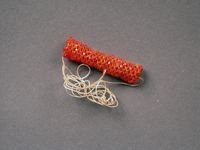
Unfinished red glass beadwork made by a Dutch Jewish girl in hiding
Object
Unfinished length of red glass beadwork made by Rachel “Chelly” de Groot from November 1942 to April 1944 and recovered by her brother Louis after the war. The beadwork may have been for a bracelet. Nazi Germany invaded the Netherlands on May 10, 1940, and implemented anti-Jewish restrictions. In July 1942, the Germans began mass deportations. On November 16, 1942, Chelly, 15, Louis, 13, and their parents Meijer and Sophia left Arnhem and went into hiding after the Dutch police warned them of a raid. Meijer and Sophia hid in Amsterdam while Chelly and Louis moved around to different locations. In summer or fall 1943, Chelly went to Amsterdam to live with her parents. In December, Louis was sent to Lemmer to live with the Onderweegs family. In February 1944, Dirk Onderweegs visited and offered to take Chelly to a safer hiding place. On April 8, 1944, four days before Dirk was to return, Chelly and her parents were denounced and arrested. They were sent to Westerbork transit camp, then to Auschwitz. Chelly and Sophia were killed upon arrival in Auschwitz on May 22, 1944. Meijer was selected for a work detail and was killed on September 30, 1944. Louis remained in hiding with Onderweegs until liberation in mid-April 1945.
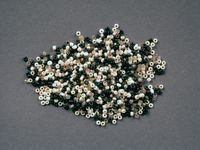
Small black, white, gold, and clear glass beads used by a Dutch Jewish girl in hiding
Object
Several tiny black, white, gold, and clear glass beads used by Rachel “Chelly” de Groot from November 1942 to April 1944 and recovered by her brother Louis after the war. Chelly used the beads to make handicrafts. Nazi Germany invaded the Netherlands on May 10, 1940, and implemented anti-Jewish restrictions. In July 1942, the Germans began mass deportations. On November 16, 1942, Chelly, 15, Louis, 13, and their parents Meijer and Sophia left Arnhem and went into hiding after the Dutch police warned them of a raid. Meijer and Sophia hid in Amsterdam while Chelly and Louis moved around to different locations. In summer or fall 1943, Chelly went to Amsterdam to live with her parents. In December, Louis was sent to Lemmer to live with the Onderweegs family. In February 1944, Dirk Onderweegs visited and offered to take Chelly to a safer hiding place. On April 8, 1944, four days before Dirk was to return, Chelly and her parents were denounced and arrested. They were sent to Westerbork transit camp, then to Auschwitz. Chelly and Sophia were killed upon arrival in Auschwitz on May 22, 1944. Meijer was selected for a work detail and was killed on September 30, 1944. Louis remained in hiding with Onderweegs until liberation in mid-April 1945.
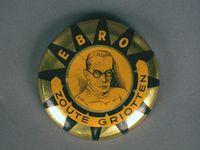
Tin candy container and lid used to store beads by a Dutch Jewish girl in hiding
Object
Ebro candy tin used by Rachel “Chelly” de Groot from November 1942 to April 1944 and recovered by her brother Louis after the war. Chelly used the box to store small red glass beads that she used to make handicrafts. Nazi Germany invaded the Netherlands on May 10, 1940, and implemented anti-Jewish restrictions. In July 1942, the Germans began mass deportations. On November 16, 1942, Chelly, 15, Louis, 13, and their parents Meijer and Sophia left Arnhem and went into hiding after the Dutch police warned them of a raid. Meijer and Sophia hid in Amsterdam while Chelly and Louis moved around to different locations. In summer or fall 1943, Chelly went to Amsterdam to live with her parents. In December, Louis was sent to Lemmer to live with the Onderweegs family. In February 1944, Dirk Onderweegs visited and offered to take Chelly to a safer hiding place. On April 8, 1944, four days before Dirk was to return, Chelly and her parents were denounced and arrested. They were sent to Westerbork transit camp, then to Auschwitz. Chelly and Sophia were killed upon arrival in Auschwitz on May 22, 1944. Meijer was selected for a work detail and was killed on September 30, 1944. Louis remained in hiding with Onderweegs until liberation in mid-April 1945.
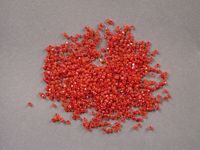
Small red glass beads used by a Dutch Jewish girl in hiding
Object
Small red glass beads used by Rachel “Chelly” de Groot from November 1942 to April 1944 and recovered by her brother Louis after the war. Chelly used the beads to make handicrafts. Nazi Germany invaded the Netherlands on May 10, 1940, and implemented anti-Jewish Semitic restrictions. The Germans began mass deportations in July 1942. On November 16, 1942, Chelly, 15, Louis, 13, and their parents Meijer and Sophia left Arnhem and went into hiding after the Dutch police warned them of a raid. Meijer and Sophia hid in Amsterdam while Chelly and Louis moved around to different locations. In summer or fall 1943, Chelly went to Amsterdam to live with her parents. In December, Louis was sent to Lemmer to live with the Onderweegs family. In February 1944, Dirk Onderweegs visited and offered to take Chelly to a safer hiding place. On April 8, 1944, four days before Dirk was to return for Chelly, Chelly and her parents were denounced and arrested. They were sent to Westerbork transit camp, then to Auschwitz. Chelly and Sophia were killed upon arrival in Auschwitz on May 22, 1944. Meijer was selected for a work detail and was killed on September 30, 1944. Louis survived the Holocaust in hiding with the Onderweegs family.
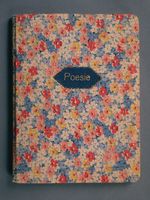
de Groot family autograph album
Document
Hand covered autograph and poetry notebook used by Rachel (Chelly) de Groot while in hiding in the Netherlands. It was recovered by her brother Louis after the war.
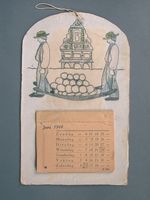
Handmade 1944 calendar made by a hidden Dutch Jewish girl for her brother
Object
Handmade calendar made by 16 year old Rachel “Chelly” de Groot for her 14 year old brother Louis while they were in hiding in separate places in the Netherlands in 1944. Chelly copied an image of the Alkmaar Cheese Market, depicting two men carrying cheese in front of the Alkmaar Weigh House. Louis received the calendar after Dirk Onderweegs, the resistance member Louis was staying with, visited his family in February 1944. The calendar displays June 1944 because Louis and the Onderweegs had to flee their home in June, after they were turned into the Gestapo for their resistance activity. Germany occupied the Netherlands in May 1940 and implemented anti-Jewish restrictions. In July 1942, the Germans began mass deportations. On November 16, 1942, Chelly, 15, Louis, 13, and their parents Meijer and Sophia left Arnhem and went into hiding. Meijer and Sophia hid in Amsterdam while Chelly and Louis moved around to different locations. In summer/fall 1943, Chelly went to Amsterdam to live with her parents. In December, Louis was sent to Lemmer to live with the Onderweegs family. In February 1944, Dirk Onderweegs visited and offered to take Chelly to a safer hiding place. On April 8, 1944, four days before Dirk was to return, Chelly and her parents were denounced and arrested. They were sent to Westerbork transit camp, then to Auschwitz. Chelly and Sophia were killed upon arrival in Auschwitz on May 22, 1944. Meijer was selected for a work detail and was killed on September 30, 1944. Louis remained in hiding with Onderweegs until liberation in mid-April 1945.



